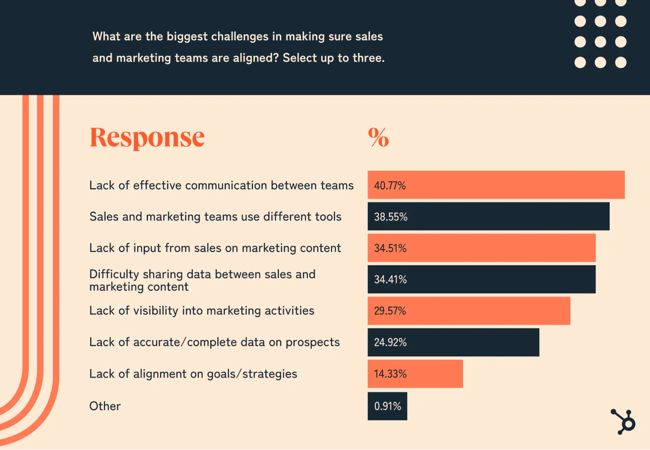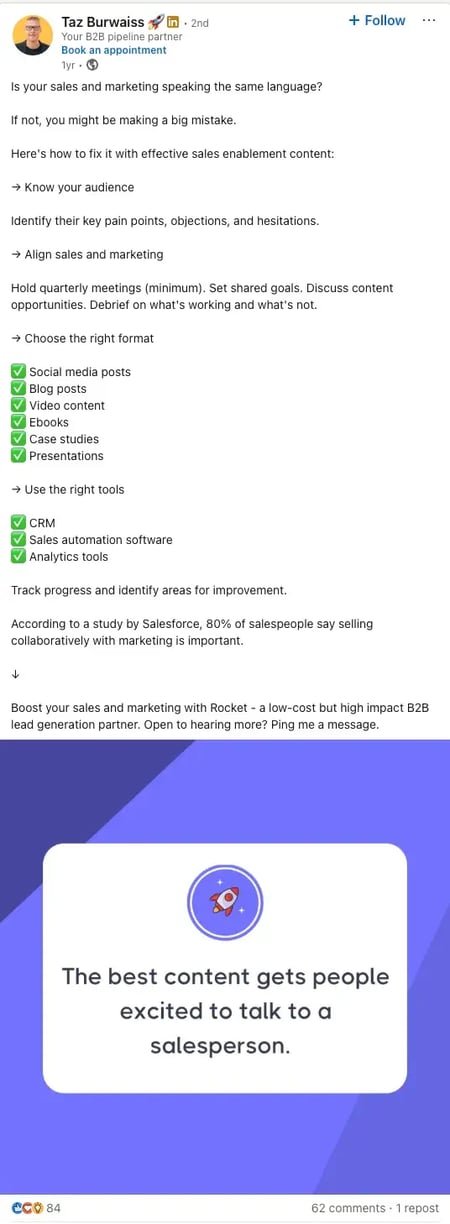I pulled up my LinkedIn feed last week and noticed how half the posts from sales leaders looked like they could have been written by content marketers.
They were teaching, sharing frameworks, and posting case studies. One VP of Sales I follow had published a carousel about buyer psychology that got more engagement than most of our marketing content.
As someone who works in content strategy for B2B SaaS companies and also sells my own services, I‘ve watched this shift happen in real time. The line between sales and marketing has blurred so much that I sometimes forget which hat I’m wearing.
Data from HubSpot’s 2025 State of Sales Report shows sales teams are borrowing from the marketing playbook, and it’s working. Research shows that 40% of sales teams have expanded their offering of self-serve tools like pricing pages and customer stories in the past year — resources that have lived on the marketing side of the house.
Here‘s what’s driving this convergence and what it means for how we sell.
Table of Contents
- Sales and Marketing Behaviors Are Converging: The Trends
- Sales and Marketing Alignment Matters
- Tips Sales Teams Can Learn From Marketers
Sales and Marketing Behaviors Are Converging: The Trends
The data reveals specific ways sales teams are adopting tactics that were once exclusively in marketing’s domain. Here are the trends reshaping how sales operates.
Social media has become the primary sales channel.
Sales reps are now doing what marketers have done for years: building audiences, creating content, and nurturing relationships in public spaces.
Social media delivers a 42% cold outreach response rate, nearly double that of email (26%) and phone calls (23%). It’s also rated “very effective” at driving sales by 45% of professionals, edging out even in-person meetings at 44%. Perhaps most telling, 35% identify social media marketing as their number one source of high-quality leads.

Traditional sales was about private, one-to-one conversations controlled by the rep. Social selling is about public visibility, consistent value sharing, and building trust before the first conversation even happens.
Reps are publishing thought leadership. They’re commenting on industry trends and sharing customer success stories. They’re creating content calendars to optimize posting times and measuring engagement rates.
These are marketing behaviors. The convergence happens because buyers now expect to vet sellers the same way they vet products. That includes consuming their content and assessing their credibility before ever responding to outreach.
Sales teams are prioritizing marketing assets and self-serve resources.
Sales reps are no longer waiting for prospects to request information. They’re working with marketing to put value front and center before the first conversation even happens.
The data backs this shift. 40% of sales organizations expanded their self-serve tools in the past year. Think free trials, transparent pricing pages, and detailed customer stories. Another 35% moved toward solution-based selling, which requires the same educational content that marketing has been producing for years.
This represents a fundamental change in how sales operates. Instead of gatekeeping information to control the conversation, teams are collaborating with marketing to demonstrate value upfront. The logic is simple. Buyers who educate themselves using quality resources show up to sales conversations more informed and closer to a decision.
Value demonstration trumps product pitching.
Buyers who walk away don‘t see the value of the product. HubSpot found that 37% of those who don’t buy fail to see product fit. Another 35% leave because they don’t see value for the money. Together, these two reasons account for nearly three-quarters of lost opportunities.
The most effective upsell strategy is understanding customer goals, followed closely by providing consistent value.

These are ongoing commitments to demonstrating impact at every stage of the relationship.
This approach also changes when you introduce the next opportunity. The most effective upsell conversations happen right after you’ve helped a client hit their goals, accounting for 37% of successful expansions.
At that moment, trust is highest, and your value isn’t theoretical.
Buyers research independently, forcing reps to add value differently.
Buyers no longer need sales reps to access basic product information. In fact, 74% of sellers acknowledge that AI tools have made independent research easier than ever. This shift has fundamentally changed what salespeople are actually supposed to do during conversations.
The rep’s most important role is no longer explaining features or controlling the flow of information. Instead, 36% say their primary value is helping buyers feel confident in their decisions, while 33% focus on navigating internal buy-in processes.
These responsibilities look remarkably similar to what content marketers have been doing for years. The goal is the same: Guiding people through complex decision-making journeys.
The distinction between sales and marketing tactics is blurring because the buyer’s journey has changed. When prospects arrive already educated, reps succeed by facilitating decisions rather than driving them.
Sales and Marketing Alignment Matters
The convergence of sales and marketing tactics only works if the teams behind them are actually cooperating. Nearly 91% of sales professionals report their teams are either strongly aligned or somewhat aligned.

That’s a step in the right direction, especially when you consider that both functions are increasingly nurturing prospects and building trust over time.
But the barriers to full alignment reveal where organizations still struggle. The biggest obstacles are a lack of effective communication between teams, tool fragmentation, and a lack of sales input on marketing content.

These directly undermine the convergence strategies that both teams are trying to implement.
When teams coordinate well, sales reps know exactly which self-serve resources exist, when to deploy them in conversations, and how to use enablement material to move deals forward.
The organizations seeing results from these investments are the ones where sales and marketing share goals. These departments communicate regularly about what’s working. From there, they can gather feedback and iterate based on what actual buyers need.
Tips Sales Teams Can Learn From Marketers
Sales and marketing have historically operated in separate worlds, but the best revenue teams are starting to blur those lines. Marketers bring a disciplined approach to testing, a willingness to experiment with unconventional tactics, and a long-term perspective that sales teams often lack under quota pressure.
Here’s what sales teams can borrow from their marketing counterparts to close more deals and build stronger pipelines.
Test and refine your approach the way marketers do.
Marketers don’t launch a campaign and hope for the best. They build attribution models, track conversion rates across every stage, and constantly refine based on what the data tells them. Sales teams can adopt this same test-and-learn mentality.
Kyle Lacy, ex-CMO at Jellyfish, describes how his team approaches this in The Revenue Leadership podcast. He says, “You need to build your models together. When you bring people along with you, that’s when trust is built.”
But, the underlying principle applies to sales processes too. Testing and iterating can help teams refind their approach.
At Lessonly, Lacy’s team created a revenue handbook that documented everything from lead scoring to follow-up times to account tiering.
The critical detail? “We actually had everybody sign it like an actual contract.” This created a baseline to test against and improve over time.
Sales reps can apply this thinking to their own work. Track which email subject lines get opened. Test different talk tracks on discovery calls. Analyze which objection-handling approaches actually move deals forward.
Instead of relying on gut feel or repeating the same pitch indefinitely, treat your sales process like a marketer treats a campaign. The process should be measured, tested, and optimized continuously.
Experiment with unconventional outreach, not just what’s proven.
Marketers succeed because they‘re willing to try things that don’t fit neatly into a spreadsheet. They‘ll invest in a creative campaign knowing the ROI won’t be immediate or easily measurable.
Sales teams tend to stick with what’s proven because those tactics have clear metrics attached. That’s why cold calls and templated emails have staying power.
However, the best marketing wins come from taking creative risks. Udi Ledergor, former CMO at Gong, says, “When marketers are at their peak of creativity, their bets, whether illogical or not, they’re big brand bets.” Sales reps can borrow this mindset by experimenting with outreach that stands out rather than blending in.
This might mean sending a personalized video instead of another email, like:
- Recording a custom podcast episode for a high-value prospect.
- Mailing something physical that actually required thought, not just a company-branded water bottle.
- Creating a one-page custom analysis of their business based on publicly available data.
These approaches take more time upfront and don’t scale the way mass email does. But marketing has proven that sometimes the highest-converting tactics are the ones that feel inefficient at first.
Sales teams who treat a portion of their pipeline like a creative testing ground often find ways to reach prospects that conventional outreach never will.
Speak the same language through regular alignment sessions.
Sales and marketing teams often operate with completely different vocabularies, messaging frameworks, and content priorities.
Taz Burwaiss, founder of Rocket Marketing Agency, points to this disconnect as a critical mistake: “Is your sales and marketing speaking the same language? If not, you might be making a big mistake.”

His solution centers on structured, recurring communication. Hold quarterly meetings at a minimum where both teams set shared goals, discuss content opportunities, and debrief on what‘s working and what’s not.
These sessions shouldn’t be status updates but working sessions where sales provides real feedback on messaging effectiveness. Teams can discuss actual pain points they see, objections, and hesitations prospects raise in conversations.
The format matters less than consistency. Marketing might produce social posts, blog content, videos, ebooks, case studies, and presentations. But, if sales reps don‘t know these assets exist or don’t understand how to deploy them in conversations, the investment is wasted.
Burwaiss emphasizes that alignment requires the right tools to track what’s actually moving deals forward. That means having CRM, sales automation software, and analytics in place.
According to Salesforce research, 80% of salespeople say collaborating with marketing is important. The gap isn’t in recognizing the need but in creating the operational rhythm that makes it happen consistently.
Warm up your prospects before you reach out.
Marketers understand that cold outreach rarely converts. They invest time building awareness and interest before asking for anything in return. Sales teams can borrow this playbook by layering their outreach instead of going straight for the close.
In The Modern Revenue Executive podcast, Cliff Dinwiddie, CMO at Kinetic, describes how his team orchestrates this with their door-to-door sales strategy. Marketing runs top-of-funnel campaigns first to build brand recognition in a specific market. These efforts include out-of-home advertising and social media.
Then they narrow down to individual prospects with targeted messaging before the sales team ever knocks on a door.
When sales shows up, prospects already know who they are and what they offer.
Cliff explains the sequencing, “It’s my job to warm that door up so that when the sales team shows up, someone actually is willing to open the door and have a conversation.”
Sales reps who coordinate with marketing to understand what touchpoints a prospect has already experienced can tailor their approach accordingly. They lead with context rather than starting from scratch every time.
The sales-marketing divide is closing (and that’s good for everyone).
Sales and marketing teams are always better together than apart. The data confirms what many of us already suspected: When sales reps start thinking like marketers, they close more deals and build stronger pipelines.
Sales still needs to sell, and marketing still needs to market. But, the organizations winning right now are the ones where both teams borrow freely from each other’s playbooks.
Want to see the full picture of how sales teams are adapting? Download HubSpot’s 2025 State of Sales Report for complete findings on what’s working, what’s changing, and where sales is headed next.
![]()

![Download Now: 2025 Sales Trends Report [New Data]](https://no-cache.hubspot.com/cta/default/53/9cdc68ed-d735-4161-8fea-0de2bab95cef.png)